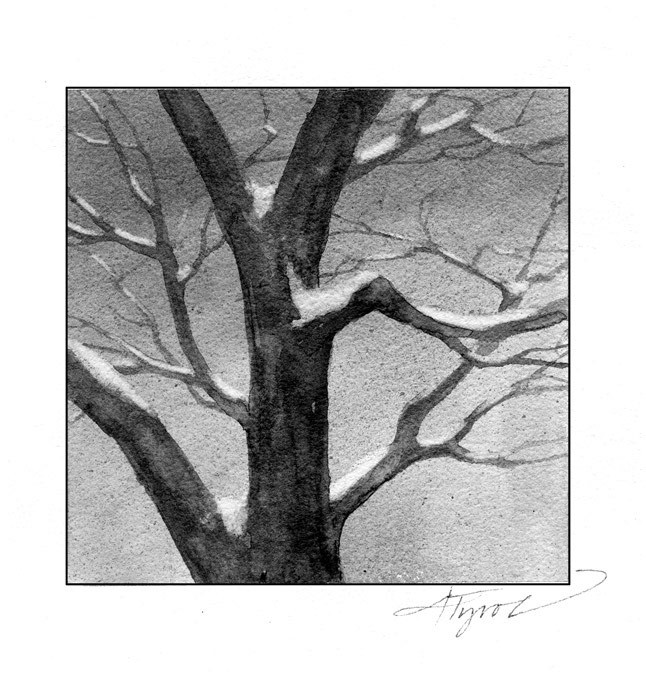
We take for granted that trees drop their leaves in fall and open their buds in spring, with a glorious burst of flowers and leaves. Indeed, florists know that apple branches cut in March and brought inside will flower in a vase in just a few weeks. Yet if you were to cut branches from the same tree in November and bring them indoors, they would never sprout. What accounts for the difference?
Trees survive sub-freezing winters by becoming dormant, a gradual process that begins long before winter. As summer gives way to autumn, cooling temperatures and lengthening nights tell trees to stop elongating their twigs and make resting buds instead. As growth slows, so does chlorophyll production, and leaves begin to change color. A layer of cork starts to form across the base of the leaf stem, cutting off nutrients and eventually causing the leaf to drop.
Lack of growth and dying leaves however, do not mean that a tree is truly winterized. Trees, or their cut branches, may still be roused into sprouting in early fall, as they are only in a state of pre-dormancy. This condition is a general response to environmental stress. In other words, pre-dormancy is brought on not just by lengthening nights but also by some other stress, like drought. Those occasional trees that we notice turning color and dropping their leaves in midsummer are stressed. They are shutting down their metabolic activity, but in this pre-dormant state, they would still recommence growth if conditions again became favorable.
However, in temperate zones, the onset of fall brings shortening days as well as cold, and together these signals send trees into the next phase of dormancy, called true dormancy, which begins a few weeks after growth cessation.
Trees sense day length (actually night length) through phytochrome, a blue pigment that exists in two interconvertible forms. Native phytochrome converts to ‘activated’ phytochrome when hit by a photon of red light. In the dark, the activated phytochrome reverts to the native form. The amount of time in the dark required for all the activated phytochrome to return to the native state is how plants measure the length of the night. Long nights lead to the production of abscisic acid, which inhibits bud growth, promotes cork formation at leaf bases, and stimulates the complex ‘hardening off’ process that transforms the delicate live tissues of trees into something that can withstand severe cold.
Once truly dormant in late fall, trees will not respond in any fashion to warm temperatures. Before becoming receptive to wake-up calls, a certain amount of time in the cold must first accrue. This is referred to as the number of chill hours. Extreme cold, however, is not necessary. Trees start racking up chill hours at 44 degrees F, and it is generally accepted that below 30 degrees F, chill hours don’t accumulate. It’s the time spent between 44 and 30 degrees F, generally through fall to midwinter, that counts. This hints at some yet-to-be-defined biological counting process that grinds to a halt once tissues and cells are below freezing.
During true dormancy, trees become progressively more resistant to freeze damage through cellular changes and accumulation of frost- and stress-protective compounds.
Like many insects and amphibians that also withstand our northern winters, trees evacuate water from their cells, turn starches into sugary antifreezes, add fatty acids to keep their cell membranes supple, and take advantage of pure water’s super-cooling properties to withstand temperatures far below where water would otherwise freeze.
While it is not known how trees ‘count’ their genetically programmed chill-hours, recent research shows that some genes, including those that protect cells from the stress of dehydration, remain active during dormancy. At the end of chill-hour accumulation, the activity of these genes decreases while other genes become active, producing, among other things, antioxidants and vitamin C. These compounds get rid of hydrogen peroxide, an oxidizing agent that builds up during true dormancy and would damage plant tissue it if were still around once the trees resumed growing.
In New Hampshire and Vermont, trees have typically accumulated their necessary chill hours by sometime in January, when changes in gene activity herald entry into the post-dormant phase. At this point, they are held in check by the cold, not the length of the day. And because the post-dormant phase includes the coldest part of the year (January and February), freeze resistance actually reaches its peak during post-dormancy, then declines gradually as the cold eases.
The arrival of warm temperatures in April, more than increased day length, induces trees to open their buds. Usually the timing is appropriate, though unseasonable early warmth can sometimes fool trees, as in the early opening of apple blossoms and oak and maple leaves in April and May of 2010. All three species suffered from a late frost in May.


Discussion *